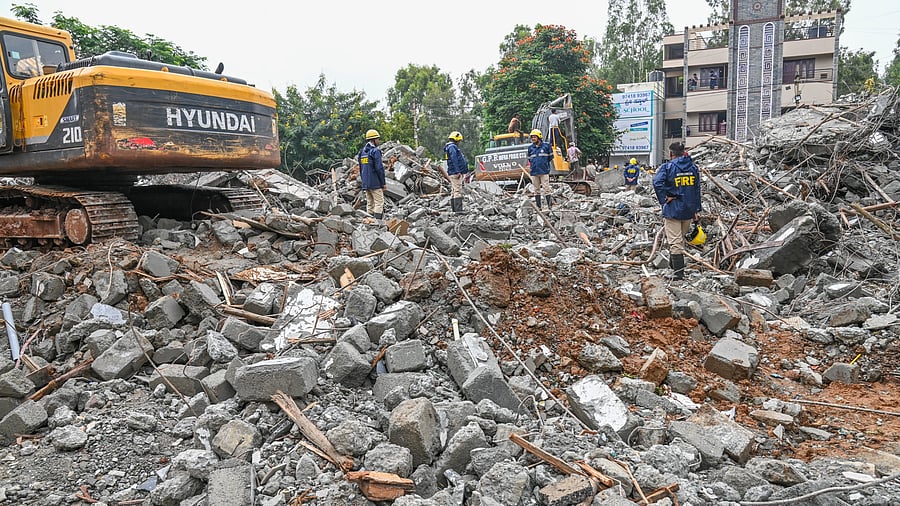
The under-construction apartment building in eastern Bengaluru's Babusapalya collapsed on Tuesday. Eight construction workers died in the collapse.
Credit: DH photo
Bengaluru: The recent collapse of an apartment building in Bengaluru's Babusapalya, which resulted in the tragic death of eight workers, has shed light on a legal loophole that encourages illegal constructions to thrive in the city.
Many residents who have exposed unauthorised constructions in their neighbourhoods have not succeeded in pursuing their legal battles to a logical conclusion, as the BBMP Act, 2020, allows the civic body to self-police, effectively rendering the legislation "toothless".
In the chapter titled 'Regulation of Buildings, Including Town Planning' of the BBMP Act, two sections are primarily used to address illegal constructions.
First, Section 248 grants the BBMP the authority to issue a notice to builders who unlawfully begin constructions.
Second, if a builder fails to comply with the building bye-laws, Section 356 allows the BBMP to order the builder to demolish the unauthorised structure at their own expense. If the builder does not take action within 30 days, the BBMP itself is empowered to carry out the demolition.
While the civic body diligently follows Section 248 and a part of Section 356 — the process of issuing notices and seeking a response can take up to three months — the authorities often fail to take further action, including the demolition of unauthorised structures.
The reason for this inaction is intriguing. Citizen groups fighting against illegal buildings point to a loophole in the BBMP Act, which has a vague description about punishment to officers for failing to prevent unauthorised constructions.
Section 252 states that the jurisdictional officer who fails to prevent unauthorised deviations or constructions within their jurisdiction shall be liable for "such punishment as may be prescribed".
For a long time, there was no clarity on who the "jurisdictional officer" was for preventing unauthorised constructions. The responsibility, time and again, swayed between assistant executive engineers and joint directors (town planning). According to an internal circular issued by the BBMP on September 18, this responsibility has now been assigned to the zonal commissioners.
While the BBMP has specified responsibility without making it public, the penalties for failing to fulfill their duties remain vague. This lack of clarity is why the civic body often does not proceed with demolitions of unauthorised structures, even when ordered by a court. The phrase "such punishment as may be prescribed" is determined only after an internal inquiry which officers and engineers often do not fear.
Suhas A Rajkumar, who practised law for many years, stated that the BBMP conducting its own inquiries was tantamount to self-policing.
"Since engineers and officials do not face any consequences for failing to prevent unauthorised constructions, we rarely see the BBMP demolishing unauthorised buildings. If there were an independent tribunal, there would have been at least one demolition every month. Now, constructing two illegal floors has become the norm, and it will soon escalate to three or more.”